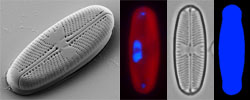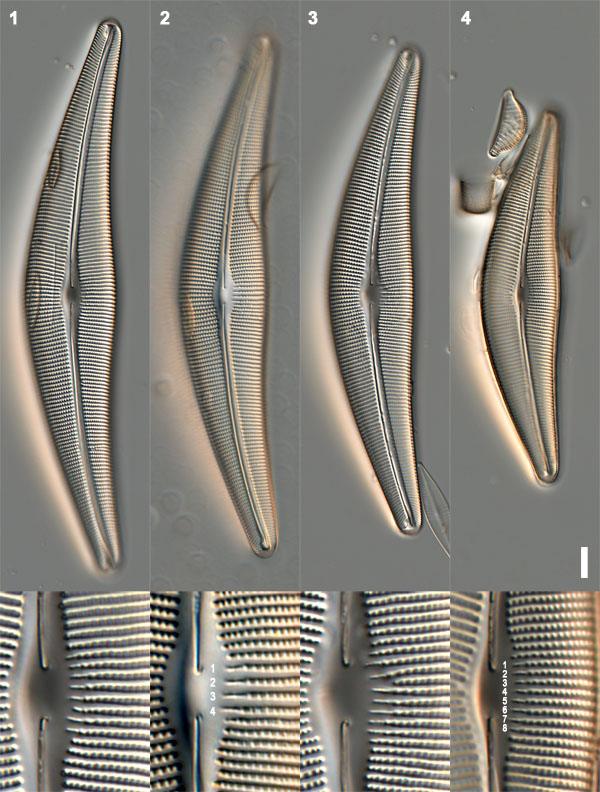The valves shown vary in length from 180 µm (Fig. 1) to 122 µm (Fig. 4). These and other valves on the same slide measure 27 to 31 µm in width, the longest valves generally being the widest. There are 8 to 10 striae in 10 µm (measured near the raphe at the centre), and 11 to 13 areolae in 10 µm along the striae.
The number of stigmata (the transversely elongate, slit-like markings on the right-hand side of the centre: see the four close-ups at the bottom) is generally 6 or more in the Blackford Pond population . They are numbered 1 to 8 in the detail of Fig. 4. Sometimes it is difficult to decide from light microscope observations whether a particular pore near the centre is a stigma or a normal pore (= areola). However, in the valve shown in Fig. 2, it is clear that there are only four stigmata. This and the variation in valve width leads to uncertainty about the identification of these valves. In the older literature, these valves would have been identified as Cymbella lanceolata. However, this name is not appropriate, since the original "Cymbella lanceolata", described by C.A. Agardh in 1827 does not belong to Cymbella in the modern sense of the genus. According to Silva et al. (2013), two names can be applied to diatoms like those shown above: C. cornuta Ehrenberg and C. neolanceolata W. Silva. Cymbella cornuta is supposed to differ from C. neolanceolata in being narrower (only 16.5 to 18 µm wide, as opposed to 19.2 to 24.6 µm), being more rounded at the ends, and having fewer stigmata (only 4, as opposed to 6 to 10). On this basis, the Blackford specimens are intermediate between C. cornuta and C. neolanceolata, having the greater width and more acute ends of C. neolanceolata, but exhibiting a range of stigma numbers that encompasses C. cornuta.
The ranges of length given for C. neolanceolata (86 to 133 µm) and its var. bottnica (125 to 161 µM) by Silva et al. (2013) are much less than the range given for "C. lanceolata" by Hustedt (1930: 70 to 210 µm) and less than the maximum recorded by Geitler (1927) during his studies of auxosporulation in "C. lanceolata" (225 µm). The range of length recorded for C. cornuta is even less (c. 87 µm). Even though these are familiar, common diatoms, there seem still to be uncertainties about the range of variation each species


 This site is
hosted
by
the Royal Botanic
Garden Edinburgh.
This site is
hosted
by
the Royal Botanic
Garden Edinburgh.